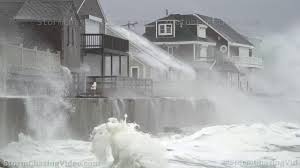Scituate Battling Through the Harsh Winters Year After Year

February 4, 2021
As each winter season goes by, East Coast sea levels continue to rise and Scituate homes and businesses experience devastating effects from Nor’easters. To store owners and oceanside homeowners, these storms bring more than a loss of power–they also bring a loss of revenue, a loss of goods, and sometimes a significant loss of property.
During recent winters, the ocean has been more of an issue than snow, causing damage to the whole town of Scituate. SHS science teacher Steve Maguire teaches Oceanography and Meteorology and knows a lot about the ocean and the rising shore. Maguire has been talking about this topic over the last 20 years. First teaching in central Massachusetts, where snow days are more frequent, Maguire said the number of snow days each year in Scituate has started to decrease, but the number of storms has doubled. Many storms happen later in the winter because that is when the ocean is coldest: “It’s clearly gotten worse in the last 10 years and way worse in the last 20,” Maguire explained. Since Maguire started teaching in 2001, the amount of flooding and storm effects on the town have become more heartbreaking and detrimental for residents.
With the increasing volume and damage of storms, many homeowners have been forced to adapt to the sea level rising. For example, several residents living near Sand Hills and Scituate Lighthouse have reconstructed their homes on pilings. Sand Hills homeowner Dan Farrington commented, “Having elevated the house and placed it high on concrete pilings has made a big difference in preventing damage as it has removed it from the direct path of storm and wave surges that would strike the house.” However, the houses that haven’t made this change will have to evaluate in the future years what to do with their property. Maguire noted, “The houses will either have to go through ‘managed retreat,’ which means they will have to pick the house up and move it, or those people will have to abandon their house.”
For the Farrington Family, living on the water is not easy, but it definitely has plenty of perks! The summers bring beautiful sunsets, low tides, beach walks, and relaxing get-togethers. Even though they have to contend with harsh winters every single year, they have never considered moving. “I have enjoyed far more ‘priceless’ days living here, waking to breathtaking views, sunrises, sunsets, than bad days could ever total,” said Dan Farrington.
Another area raising concern for oceanside residents is the Scituate seawall. Without a doubt, in the next hundred years, the seawall will need to be pushed back as a result of the rising sea level. Maguire has witnessed sea level rise in Scituate. He explained that every year Scituate experiences an exceptionally high tide, known as a “King tide,” when Cole Parkway floods completely along with the Peggotty bridge, cutting off access to First and Second Cliffs. He noted, “Those are just regular tides that 30-40 years ago never happened.” Another wake-up call to Scituate residents was the seawall that breached on Oceanside in 2010, causing massive flooding and house fires on Sixth Avenue. Because Scituate continues to be hit harder than ever during storms, the town is working to create a plan with an outside agency to protect residents living along the coastline.
The Donahue Family, owners of Nona’s Homemade Ice Cream in Scituate, Hingham, and Hanover, have first-hand experience with the harsh, stormy winters on the South Shore. Their Scituate store is located in the Harbor near the water. Krissy Donahue stated that although business is generally slow in the winter, opening the Scituate store is “weather dependent,” as winds get very high with prominent snow or rain. Keeping their employees and customers safe is a priority; however, when a storm falls on the weekend, it can be very detrimental for business. “Weekend business carries us through the winter,” explained Donahue.
To prepare for storms, Nona’s Scituate employees often transport any extra ice cream to the Hingham store because they are less likely to lose power. However, if that does happen, they are prepared with a generator. The Nona’s truck can also keep ice cream frozen for 2-3 days without a recharge if needed. This Scituate family business has experienced misfortune with buckets of ice cream melting and having to be discarded; however, they are more prepared than ever for future storms. “What we have seen through the years is that even if you have to close for a day for a storm, if it is nice the next day, people are happy to come out for ice cream!” said Donahue.
When the storms come, the news follows, and local broadcasters are typically stationed around Scituate, ready to report on any damage or destruction. People who live along the coast in Scituate are accustomed to this news coverage and question: “Why do we continue to be hit so hard?” Maguire explained that most of Scituate’s coast is northeast facing, so Nor’easter winds and tides are especially strong: “If you go from Scituate Harbor east, the next body of land you will hit is Portugal, so there is nothing to protect us, and that is why when we get these huge storms it is so devastating to the coast.”
Even though living in Scituate means dealing with harsh winters, many people would agree Scituate’s summer weather makes up for it. Perhaps Maguire said it best: “This is an amazing place to live 360 days of the year.”









